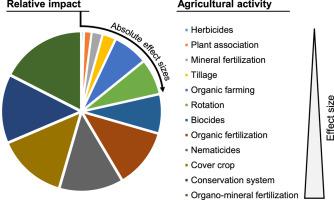Soil Biology and Biochemistry ( IF 9.7 ) Pub Date : 2021-08-06 , DOI: 10.1016/j.soilbio.2021.108383 Jérémy Puissant 1 , Cécile Villenave 2 , Camille Chauvin 2 , Claude Plassard 1 , Eric Blanchart 1 , Jean Trap 1

|
Agricultural practices significantly affect soil biodiversity and functions, altering biogeochemical cycles and potentially compromising food production. Increased employment of sustainable agricultural practices is of growing policy concern and requires a better understanding and quantification of how agriculture affects soil functioning. We conducted a worldwide meta-analysis by computing 4855 effect sizes from 103 publications to quantify the effect of agricultural practices on soil nematodes, known to be key biological indicators of soil health. Our meta-analysis summarized the effects of tillage, pesticides use, fertilization, manipulation of above-ground plant including cover crop, rotation and agricultural system shift (the conversion from the conventional to conservation or organic agriculture systems). We quantified how each agricultural practice alters nematode indices of ecological relevance including the absolute abundance of trophic groups, the taxonomic richness and diversity and the food web structure based on functional guilds. At the global level, organo-mineral fertilization, conservation system, cover crop and nematicides exhibited the greatest effect sizes (averaged all nematode indices) while herbicides, plant association, mineral fertilization and tillage had the lowest ones. At the level of trophic groups, the agricultural practices had varying impacts, e.g. crop rotation mainly reduced the abundance of the plant-feeding nematodes (−47%), cover crop mainly increased the abundance of omnivore-predators (+80%) while organic fertilization predominately promoted bacterial (+113%) and fungal feeders (+141%). Crop rotation reduced the absolute abundance of plant feeders by 47% when the rotation is longer than 2 years. At the community level, chemical inputs, monoculture and pesticide application reduced nematode abundance, the food web structure and favoured copiotrophic nematode communities. Biocides and nematicides reduced total abundance, Shannon diversity and the food web complexity of soil nematode (structure index). Using meta-regressions, our meta-analysis revealed that the effect of agricultural practices depends on the time since the last agricultural intervention (e.g. input of fertilizers, pesticide application) and on how long a practice has been adopted. This study will be a useful aid for decision maker to better manage soil nematode community and to identify gaps in current available literature. In providing the direction and magnitude of soil nematode responses to agricultural practices, the effect size produced by this study are critical in facilitating worldwide modelling of soil biodiversity under global change scenarios.
中文翻译:

量化农业实践对土壤线虫的全球影响:荟萃分析
农业实践会显着影响土壤生物多样性和功能,改变生物地球化学循环并可能危及粮食生产。增加可持续农业实践的使用越来越受到政策关注,需要更好地理解和量化农业如何影响土壤功能。我们通过计算 103 份出版物中的 4855 个效应大小进行了一项全球荟萃分析,以量化农业实践对土壤线虫的影响,土壤线虫是土壤健康的关键生物学指标。我们的荟萃分析总结了耕作、农药使用、施肥、包括覆盖作物在内的地上植物操作、轮作和农业系统转变(从传统农业系统到保护性或有机农业系统的转换)的影响。我们量化了每种农业实践如何改变与生态相关的线虫指数,包括营养群的绝对丰度、分类丰富度和多样性以及基于功能行会的食物网结构。在全球范围内,有机矿物施肥、保护系统、覆盖作物和杀线虫剂表现出最大的影响大小(所有线虫指数的平均值),而除草剂、植物组合、矿物施肥和耕作的影响最小。在营养群体层面,农业实践产生了不同的影响,例如轮作主要减少了以植物为食的线虫的丰度(-47%),覆盖作物主要增加了杂食性捕食者的丰度(+80%),而有机施肥主要促进细菌 (+113%) 和真菌饲养 (+141%)。当轮作时间超过 2 年时,轮作使植物饲养者的绝对丰度减少了 47%。在群落层面,化学投入、单一栽培和杀虫剂应用减少了线虫的丰度、食物网结构,并有利于营养型线虫群落。杀生物剂和杀线虫剂降低了土壤线虫的总丰度、香农多样性和食物网复杂性(结构指数)。使用元回归,我们的元分析表明,农业实践的影响取决于自上次农业干预(例如化肥投入、农药施用)以来的时间以及采用实践的时间。这项研究将有助于决策者更好地管理土壤线虫群落并确定当前可用文献中的差距。


























 京公网安备 11010802027423号
京公网安备 11010802027423号